#laocoon and his sons
Text
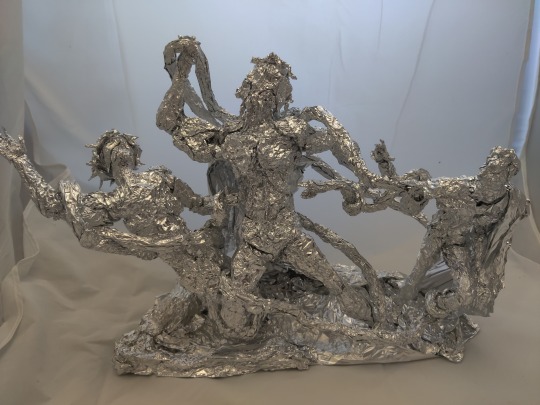
Laocoon and His Sons - Aluminum Foil Sculpture
#laocoon and his sons#greek#greek sculpture#greek art#roman#snake#hellenistic#hellenistic art#foil#sculpture#fanart
405 notes
·
View notes
Text
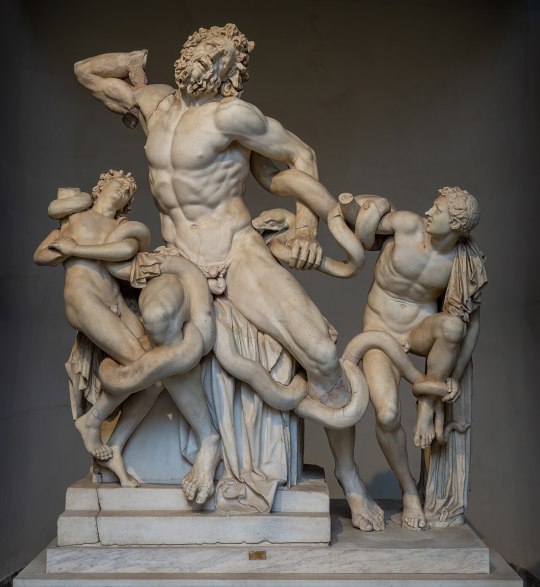
LAOCOÖN AND HIS SONS | b. 323 BCE - 31 CE | by ATHENEDOROS, POLYDOROS, and ATHENEDOROS
The sculpture depicts a dramatic scene of Laocoön, a Trojan priest, and his two sons being attacked by sea serpents. Laocoön is shown with his arms outstretched in a gesture of despair as he tries to fight off the serpents. His sons are also shown in a state of anguish, their bodies twisting and contorting as they struggle against the serpents.
The style of the sculpture is a blend of Greek and Roman influences, reflecting the Hellenistic period in which it was created. The figures are idealized and show a strong sense of emotion, which was a characteristic of Hellenistic art. However, the use of drapery and the overall composition of the sculpture is reminiscent of earlier Greek sculptures.
The sculpture has a strong symbolic meaning, reflecting the ancient Greek belief in the power of fate and the inevitability of suffering. The serpents in the sculpture are seen as a symbol of the gods' anger and punishment, as Laocoön had warned the Trojans against accepting the Trojan Horse during the Trojan War.
One of the most interesting aspects of the Laocoön sculpture is its collaborative creation. Each sculptor was responsible for a different part of the sculpture. Athenedoros was likely responsible for the overall composition and the figures of Laocoön and one of his sons. Polydoros is thought to have sculpted the other son, while Athenedoros the Younger is believed to have sculpted the serpents.
This collaborative approach resulted in a harmonious and cohesive sculpture, with each part seamlessly blending into the next. It also allowed for a more efficient and faster creation process, as each sculptor could work on their own part simultaneously.
#laocoon and his sons#sculptures#hellenistic#hellenism#hellenic deities#hellenic polytheism#hellenic pagan#trojan war#trojan horse
25 notes
·
View notes
Text
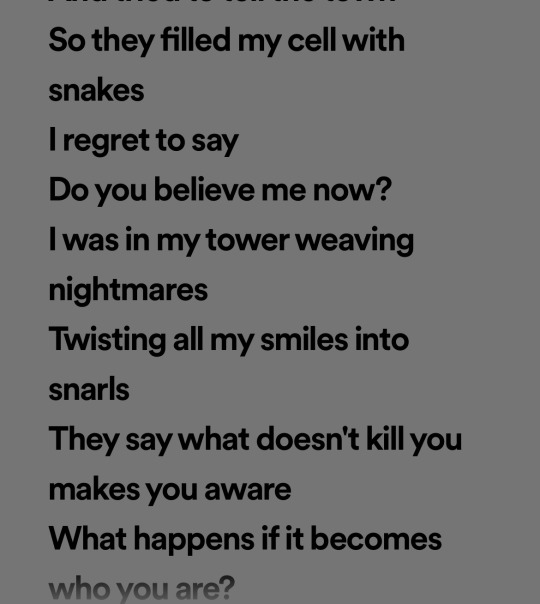
I have not seen anyone else talk about this and it's killing me. She says "so they filled my cell snakes" which I can only interpret as a reference to Laocoon, who was another Trojan who saw the future and had no one believe him and when the Trojan horse was pulled in he attempted to stop it only for him and his sons to be strangled by snakes Athena sent (which I could also tie into the Christianity that she mentions especially because the entire war was started over an apple which also translates to manus in Latin but because of this myth the Roman's have the same translation for evil.) Then she says in my tower weaving nightmares, which I can only assume is a reference to Penelope, Odysseus' wife, who refused to take on a new suitor until she was done with her loom, but every night she'd unravel it and start over because she was still waiting for Odysseus to get back.
#cassandra of troy#cassandra taylor swift#the illiad#penelope of ithaca#the odyssey#odysseus#the trojan horse#laocoon and his sons#greek mythology#roman mythology#can you tell I take a Latin class
8 notes
·
View notes
Text
The Mystery of Laocoon and His Sons
I just find it interesting how in the 500+ years since its excavation, scholars STILL can't decide on when this thing was made. I mean that genuinely. We don't know. There's theories, but it's a whole spiderweb with contradictions, and so much has been lost to history that we just can't be sure of anything.
The first and one of the most widely accepted theories is that it can be dated to around the 1st cent. B.C.E. due to textual evidence as well as some decisively dateable statue groups found in Sperlonga in the late 1950s in Tiberius's Grotto (~125ish B.C.E.), but this is debatable for a variety of reasons as well.
Pliny the Elder, in his text from Natural History, XXXVI, 37 describes a statue group VERY similar to this one that was immediately thought of upon excavation (so quickly, in fact, that it's been brought under suspicion, more on that later). The text reads:
“This is the case with the Laocoön in the palace of the emperor Titus, a work superior to any painting and any bronze. Laocoön, his children and the wonderful clasping coils of the snakes were carved from a single block in accordance with an agreed plan by those eminent craftsmen Hagesander, Polydorus and Athenodorus, all of Rhodes.”
It is important to note that the Sperlonga Groups (fig.2) are associated with the Laocoon Group because they are inscribed with the names of the sculptors that are listed here in Pliny (i.e. Hagesander, Polydorus and Athenodorus).
However, this text is drawn into question for several reasons:
The statue group was not found in the palace of Titus, it was found in a room (not buried like the vast majority of statues thought to be this old), in a vineyard. Yeah, statues can be moved, but you'd think that if one were to move such a big piece into this literal room, it wouldn't have been kept so quiet? smuggling? sure? maybe? but then buyers aren't just gonna keep this thing hidden, would they? idk
The Laocoon Group found in 1503 that is on display in the Vatican Museum today is crafted of 7 pieces (at least) and the one Pliny describes is carved in the round. It can be said that Pliny may not have gotten a close enough look and only thought that it was in the round, but the construction of 7 pieces and the detail that can be involved comparatively, eh, again, idk...
The marbles and carving/detailing styles of the Laocoon statue group and the ones found in Sperlonga are also different. The Laocoon Group is Parian marble (paria lithos) and the one's found in Sperlonga were a Rhodian variety that was also used in the Pergamon reliefs (2nd/3rd cent. B.C.E. [another theorized dating for the Laocoon group]) known as lithos larticos.
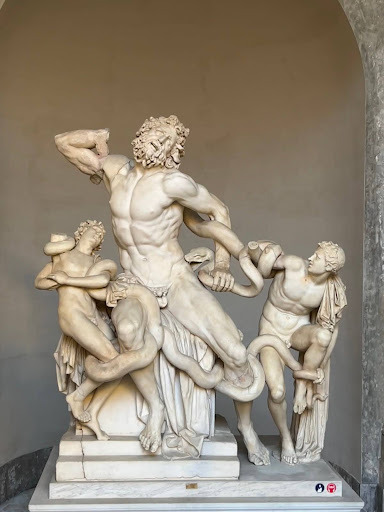
(fig.1) Laocoon and His Sons as seen in modern day at the Vatican Museum in Vatican City, Rome, Italy. Photo is property of the author, taken 12 Jan 2024.

(fig. 2) Reconstruction of the Tiberian Cave in Sperlonga: A) Group of Ulysses dragging the body of Achilles, B) Sculptural group of Scylla, C) Sculptural group of the blinding of Polyphemus, D) Sculptural group of the kidnapping of Palladium, E) Ganymede kidnapped by Zeus' eagle.
This is just a bite-size version of my larger research that I found interesting, I will definitely continue adding to it in a type of series because there are so many theories (including that it may be a Michelangelo forgery), and I want to go into mythological significance as well as reconstruction efforts.
#Laocoon#Laocoon statue group#myth#classic#classical literature#classical mythology#classics#ancient greece#imperial rome#Michelangelo#the trojan war#the trojan horse#Laocoon and His Sons#Hellenistic#Art#Sculpture#ancient history#art history#hyperfixation#rabbit hole researcher#ancient art#ancient#ancient civilizations#study notes#study motivation#rabbit hole research#college#college life
6 notes
·
View notes
Text
Two statues that blew my mind in Rome
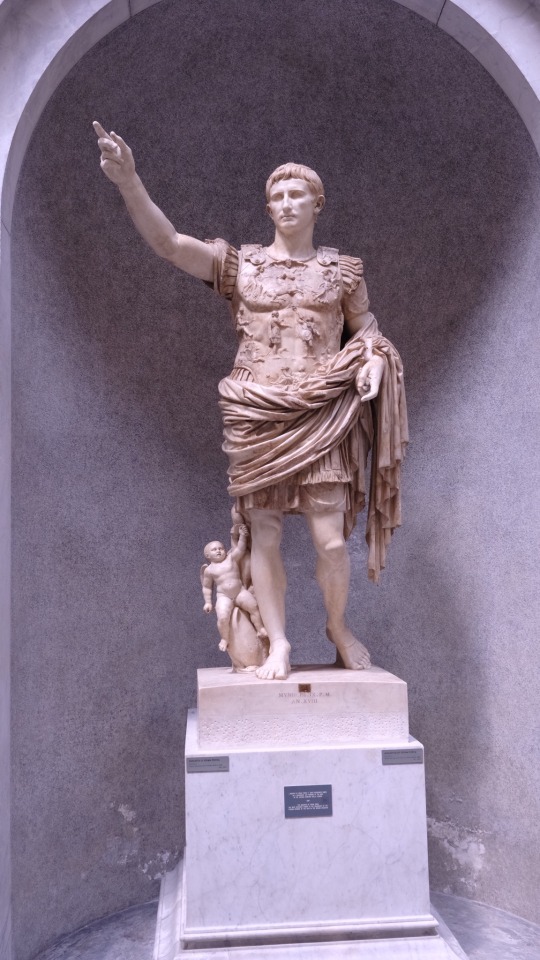
Augustus of Prima Porta from around 15 A.D. (roughly 2008 years old)

Laocoon and His Sons from around 323 BCE (roughly 2346 years ago)
🤯
#rome#roman history#augustus caesar#Augustus of Prima Porta#Laocoon and His Sons#the vatican#vatican museums#statues#marble statue#amazing#art#sculpture
9 notes
·
View notes
Text

study of laocoon and his sons i did for some anatomy practice ⭑
pls don’t repost anywhere !!
#hellenistic period#hellenistic#statue study#greek statue#anatomy study#anatomy sketch#sketch#doodle#artists on tumblr#digital art#laocoon and his sons#laocoon#hellenistic statue#greek mythology#trojan war
13 notes
·
View notes
Photo
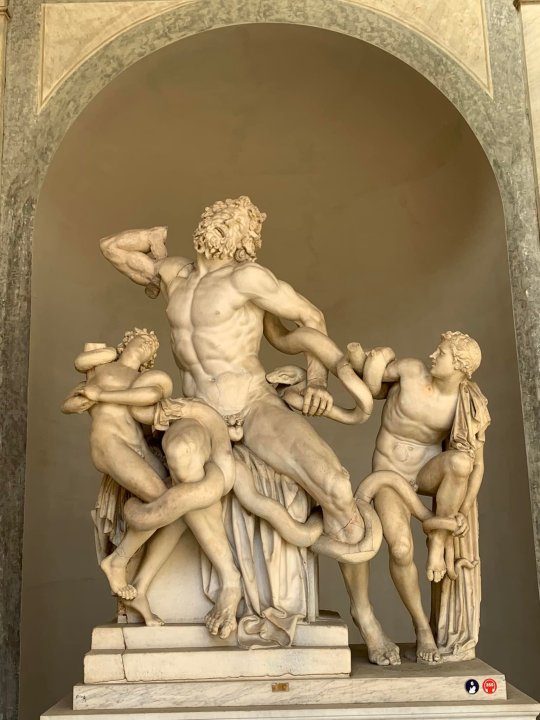
Gruppo del Laocoonte
#laocoon and his sons#my post#art#sculpture#vatican city#the vatican#travel#places#Greek Mythology#roman mythology#italy#rome#photography#photo
11 notes
·
View notes
Text
The Art of "The Passion of St. George"
Classical art is a huge part of the narrative in my story, “The Passion of St. George.” Not only is it an art piece with a mythological subject that instigates the horror and starts the plot, but Sally, the main character, is an art history major and very passionate about art. Because of this, Sally references a lot of real art pieces in her narration. I thought would be a good idea to put…

View On WordPress
#art#august clesinger#francisco de goya#Saturn devouring his son#the passion of st. george#woman bitten by a serpent#sir john everett millais#ophelia#laocoon and his sons#william adolphe bouguereau#dante and virgil#judith slaying holofernes#artemisia gentileschi#gian lorenzo bernini#the ecstasy of saint theresa#teresa of avila#brittanytaylorbarber#tw gore
5 notes
·
View notes
Photo
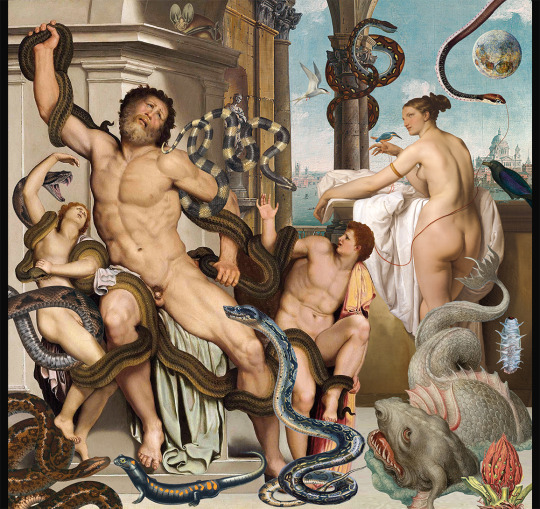
Laocoon and his two sons Antiphas and Thymbraeus being killed by giant snakes
31 notes
·
View notes
Text
Someone should get two pet snakes and name them Agamemnon and Menelaus.
#see i dont actually know how well this analysis is known so maybe i sound crazy#but in my latin class a while back we were talking about how the snakes that ate laocoon and his sons#were also metaphors for agamemnon and menelaus#the aeneid#agamemnon#menelaus#trojan war#dante dicit
3 notes
·
View notes
Text
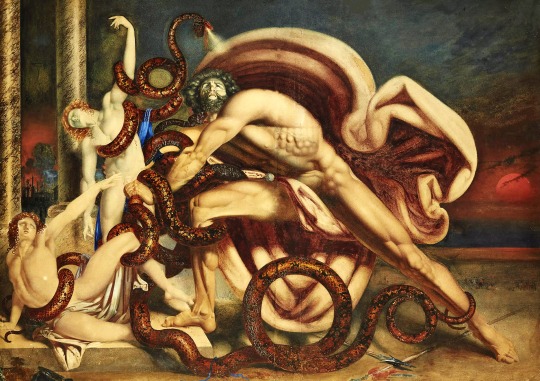
Laocoon and his Sons. 19th.century. circle of Richard Westall British 1765-1836. watercolour and body colour heightened with gum arabic with touches of white. http://hadrian6.tumblr.com
139 notes
·
View notes
Photo

Laocoön: The Suffering of a Trojan Priest & Its Afterlife
The sculpture group of Laocoön and His Sons, on display in the Vatican since its rediscovery in 1506, depicts the suffering of the Trojan prince and priest Laocoön (brother of Anchises) and his young sons Antiphantes and Thymbraeus and is one of the most famous and fascinating statues of antiquity. In his Natural History, Pliny the Elder states that the Laocoön, created by the eminent Rhodian sculptors Hagesander, Polydorus, and Athenodorus, “is a work of art to be preferred to any other painting or statuary” (36.37). Among art historians, the sculptural group has received near-universal acclaim ever since its rediscovery under questionable circumstances in 1506.
Is the statue famously shown since its discovery in the newly designed Belvedere Garden at the Vatican Palace actually the ancient sculpture mentioned by Pliny, or rather a clever Renaissance forgery? If the latter, who may have contrived this masterful deception? If the former, is it an original, or a marble copy of a Hellenistic bronze made for a Roman patron?
Beware of Greeks Bearing Gifts
In the most famous version of the story, as told by Virgil (70-19 BCE) in his Aeneid, Laocoön had warned his fellow citizens against the Greeks “even if they bear gifts,” and had tried to expose the true nature of the wooden horse by striking it with a spear (the wooden horse in question, of course, being the notorious “Trojan Horse”, left by the Greek forces on the coast so as to provide access into the city to the troops hidden inside the construction). When later two serpents emerged from the sea to kill the priest and his sons, the Trojans interpreted their horrific deaths as an act of divine retribution and promptly decided to move the wooden horse into the city, believing the contraption to be an offering to Minerva (Athena).
According to Arctinus of Miletus, the earliest tradition of the tragedy (surviving only through later citations), Apollo had sent the two serpents to kill Laocoön and only one of his sons; while the later author Quintus of Smyrna maintains that the serpents killed both sons but spared the father.
Servius, another late authority (c. 400 CE), tells us how Laocoön managed to incur the wrath of Apollo by sleeping with his wife before the cult statue in the god's temple. An even later source, the Byzantine scholar Tzetzes, adds that the scene of Laocoön's death took place in the very temple of the Thymbraean Apollo – appropriately setting the punishment at the scene of the crime.
The 5th-century BCE Greek playwright Sophocles produced a tragedy on the subject, of which only a few fragments survive in later citations. Apart from the sources mentioned above, Hellenistic poets Apollodorus and Euphorion, the historian Dionysius of Halicarnassus, the Roman novelist Petronius, the Latin fables attributed to Hyginus, and a few other fragments, all provide various details of the tragic story.
Despite this appearance in ancient literature from the post-Homeric to Byzantine traditions, artistic representations of Laocoön's suffering are few and far between. Depictions appear in some Greek vase paintings (5th to 4th centuries BCE) and in two frescoes at Pompeii (c. 25-75 CE). The marble statue group of Laocoön and His Sons, therefore remains the most exceptional portrayal of only a handful of ancient works illustrating the suffering of Laocoön.
Continue reading...
61 notes
·
View notes
Text
I realized this weekend, while resisting the urge to do more editing on Royals/Ramblers, that it was probably time I started a notes file with all of the Shivadhverse mythology. Some of it is stashed over at @shivadh but -- again much like Laocoon's Children -- there comes a point where you need more organized notes. A kind of mini wiki that just contains stuff like everyone's description, clothes they wear, etc.
It basically means re-reading the preceding books with a googledoc file open to take notes in, so this afternoon I'm re-reading/skimming Fete For A King, with an eye towards eventually having reviewed all five published volumes and taken down anything of note, or anything I'm likely to forget (like the fact that Gregory didn't have a Photogram before meeting Eddie, or that Truly Tasty ran for five seasons).
And it's kind of fun, too, because Gregory's inner thoughts are amusing if you're reading for the first time:
Eddie was a goofball who made dumb jokes, and he certainly wasn’t appropriate for a king consort, which was the whole point of dating anyone at this point. An American television chef wasn’t going to leave it all behind to co-rule Askazer-Shivadlakia, even if he did like the food.
But it's particularly funny if you're reading it in the knowledge that not only does Eddie immigrate and marry Gregory but by book five he's basically running the government tourism commission and they're settling down with kids.
Also Gregory is basically an anxious person but it's good that in the first book he talks about it being exacerbated by the coronation, because by book five he has calmed down considerably. And I'm glad I wrote Infinite Jes as the second book, because Michaelis is imperious at the best of times but he really is a high-handed son of a bitch in Fete. Giving him a whole book about his inner life and a relationship that snaps him the fuck out of it was a good move.
149 notes
·
View notes
Text
SET FIVE - ROUND ONE - MATCH THREE


"Laocoön and His Sons" (c.27 BCE-68 CE - attributed to Agesander, Athenodoros, and Polydorus) / "Winged Victory of Samothrace" (c. 200-190 BCE)
LAOCOÖN AND HIS SONS: when i think of ancient greek marble sculpture i usually think of laocoon or artemis of ephesus (those aren't boobs they're beads! er that's offtopic) or the elgin marbles (let's not talk about those.). and of THOSE it's laocoon that fucks me up. look at them. they're in AGONY. that's MARBLE. and the snakes are amazing and the hair and ugh. and the unfairness of punishing both the sons for something they didn't do is also heartrending. learn to assign blame correctly!! (@kaerran)
WINGED VICTORY OF SAMOTHRACE: the drapery and wings feel like they are totally weightless. indomitable. (@universallygladiatornacho )
("Laocoön and His Sons" is a marble sculpture attributed to Agesander, Athenodoros, and Polydorus. It measures 208 cm × 163 cm × 112 cm (6 ft 10 in × 5 ft 4 in × 3 ft 8 in) and is located in the Vatican Museums.
"Winged Victory of Samothrace" or The Winged Nike is a sculpture made of parian marble. The sculpture is 5.57m (18.3 ft) tall, including the boat shaped base, and the statue only is 2.75m (9 ft). It was originally found in Samothrace, Greece, but is currently held in the Louvre in Paris.)
#art that fucks you up tournament#polls#atfyu polls#id in alt text#greek statue time :)#this one got accidentally posted early so this is a repost if you were one of the seven people who voted please vote again#cw nudity
158 notes
·
View notes
Text
Background Noise in Shadow
The three books near the dad:
Richard North Patterson's Protect and Defend
The Tom Peters Seminar: Crazy Times Call For Crazy Organizations
Guía del mal padre - Guide of a bad father

The dad plays Makruk (Thai Chess). It does not have checkered boards and the pieces have different names.

For instance, the piece the dad moved across the board at the beginning of his conversation with Dan . . .

it's called a Rua which translates to "boat"

Like rowboat
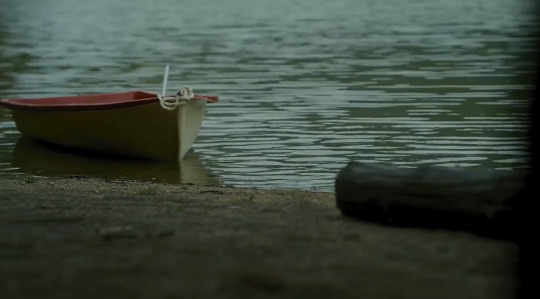
And when the dad plays it on the hospital floor, he plays it with oranges and water.

Dan and his father talked and played Makruk while sitting in water.
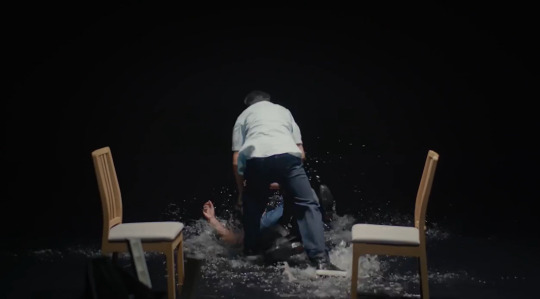
Water is a recurring motif that represents change and serves as a transition between the waking world and the dreaming one or being alive and being dead. Which is probably the reason the mountain people floated the bodies on the river and why the school serves as a hub for activity.

Hamlet deals a lot with the idea of water, sleep, and death. Hamlet believes death is a long sleep, and the famous "To be, or not to be" question is him contemplating suicide. The opening scene of the play actually questions drowning in particular because if the man goes into the water, he has caused his death, but if the water takes him under, he is not at fault (Scene 1, Act 5).

The opening scene is of the gravediggers discussing if Ophelia, Hamlet's love interest will receive a proper Christian burial. Ophelia drowned, and although never explicitly stated within the play, the assumption is it was intentional; therefore, due to Christian doctrine, she committed a sin. This conversation is repeated for Dan's mom.
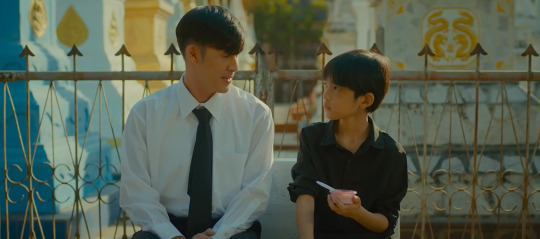
However, Hamlet's father was murdered by poison, and he haunts Hamlet to avenge his murder. We saw Trin vomiting and holding his heart when running through the woods as well as his head bleeding.
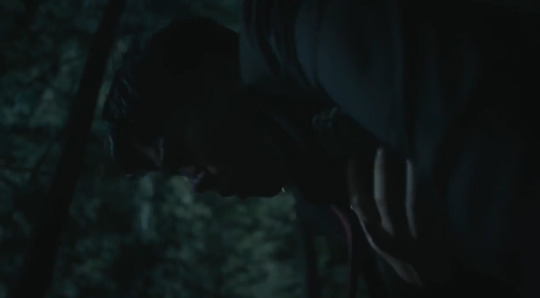
The ghost of Dan's father appears when Dan is acting out the scene in Hamlet where the ghost of his father appears to Hamlet, and the shadow appears on stage when Dan is acting out the scene right before Ophelia drowns. However, in the play, Hamlet is cruel to Ophelia telling her he is not a good man, yet he is honest. In the show, Dan messes up the line and says he is NOT an honest man, which is why the teachers look at each other.

This is the bust of Laocoon in the art class, who was murdered by sea serpents with his two sons for attempting to expose that the Trojan Horse was a ruse. The Greeks gifted a huge wooden horse to the city of Troy, yet Greek soldiers were hiding inside, so once the horse was accepted inside the city walls, the Greeks snuck out of the horse at night, attacked, and won the war. Laocoon was killed for being honest.

Hamlet is usually presented with a skull due to the opening scene depicting Hamlet realizing a skull he finds in the cemetery belonged to a former and favored court jester as he realizes death is unavoidable.
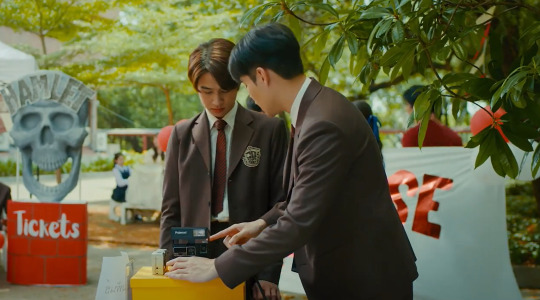

And the drawings in the art class show a skull in water and someone with orange hair drowning (which orange seems to represents rebellion).


Yet when Dan slips into the dream world, everything else is crossed out or scribbled on except for those two drawings and now the skull sits in a pool of blood and the person in the water is no longer drowning but bleeding in the water.


The show seems to be combating the idea that Trin simply drowned intentionally or even unintentionally. The shows seems to be stating that he was murdered. Probably poisoned.
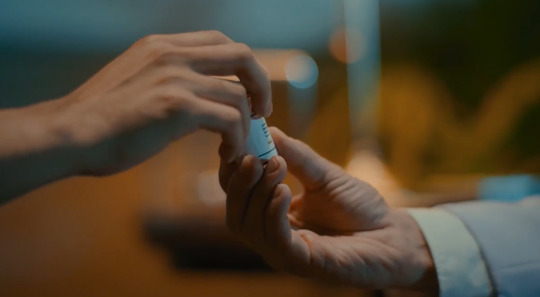

But it'd be odd if Brother Anurak did it, mostly since his name means "angel of protection."

Perhaps it has something to do with all those students lying on the ground appearing to be girls, and where the blood is coming from.

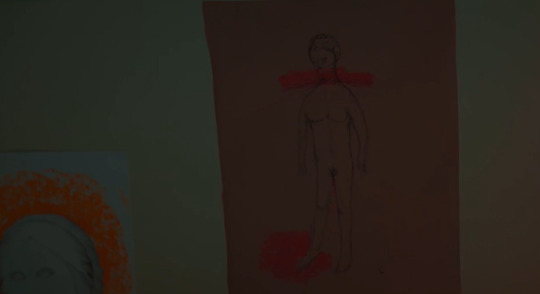
Maybe Trin found out what happened to the nurse's daughter? And maybe it has to do with that book near the dad, Protect and Defend, which is about an abortion case.

But it's all just background noise . . .

for now.
#shadow the series#background noise#water as a motif#and all this hamlet stuff#but I think there is more
69 notes
·
View notes
Text

One of the notes on the sea serpent post had this to say and I think it’s a very good point!
I’d say it’s all in how you frame it. It’s the age-old question. Like, what is a dragon? Is it “any large mythical reptile”? Or is it “a mythical serpent from European folklore that originated in the Greek drakōn, itself almost certainly an exaggerated description of a python or other large snake”? The first description could include the Chinese long, the North American horned serpent, the South American boiúna, the Australian rainbow serpent… the second, meanwhile, is a lot more restrictive.
So, in this case, what is “the sea serpent”? If the description is “a serpent that lives in the sea”, then yes, Leviathan could indeed be one of the older versions.
However!
The legend of Leviathan is that of the chaos battle, the defeat of an older water or water-adjacent deity to create order out of chaos. This is derived from the likes of Lotan and Tiamat, and there’s a clear degradation of the concept, from chthonic deities gradually being demoted to dragons/serpents of chaos and eventually great beasts that inhabit our world. It’s complicated. Leviathan also sometimes has multiple heads, something which I don’t associate with sea serpents. Tangential but worth mentioning.
Serpents that live in the sea have existed for a long time. Laocoon and his sons were killed by them. Aelian mentions them. Jormungandr is a big serpent that lives in the sea.
But it was the Scandinavian sea serpent that created the modern conception of the sea serpent as a serpent that lives in the sea which exists, and can be seen. It precipitated the whole sea serpent craze. Sober eyewitnesses reported sea serpents from all over the world.
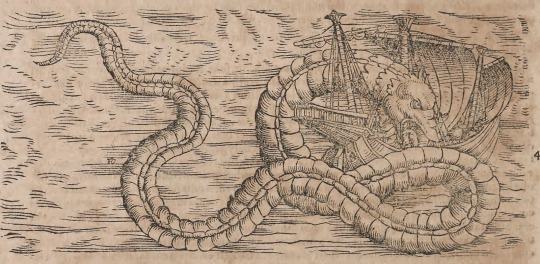
Also it is literally called “sea serpent”. Not Jormundandr or Leviathan or Tiamat or whathaveyou, but “sea serpent”, not a proper name but the name of an animal. The great Scandinavian sea serpent is, indeed, referred to as such (sjøorm).
It was Olaus Magnus’ account that created a mythic landscape in which just about every unfamiliar thing in the sea became a sea serpent, from decomposed whales to long strands of kelp

to large sea life towing marine debris

to skim feeding sei whales

to whale penises
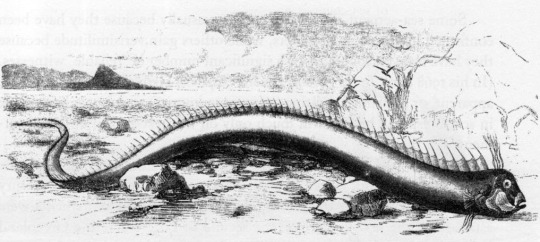
to stranded oarfishes

to whales tangled in debris (or maybe just another whale penis)
So yes, Leviathan (and Jormungandr) precede the sea serpent, and could be considered the origins of the myth, I agree! But for a more restrictive definition, I would say the sea serpent as we know it was born with Olaus Magnus’ account.
#sea serpent#leviathan#dragon#dragons#discourse#whew#that took way longer to write than it should have#but I felt it had to be said#both povs are equally valid#and there’s a lot to be said for lumping or splitting#thanks for commenting that and making me think about it!#whale penis
151 notes
·
View notes